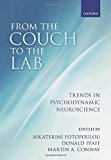From the Couch to the Lab: Trends in Psychodynamic Neuroscience
Fotopoulou, Aikaterini
Pfaff, Donald
Conway, Martin A.
Can The Psychodynamics Of The Mind Be Correlated With Neurodynamic Processes In The Brain? The Book Revisits This Important Question -one That Scientists And Psychoanalysts Have Been Asking For More Than A Century. Can The Psychodynamics Of The Mind Be Correlated With Neurodynamic Processes In The Brain? The Book Revisits This Important Question - One That Scientists And Psychoanalysts Have Been Asking For More Than A Century. Freud Envisioned That The Separation Between The Two Approaches Was Just A Temporary Limitation That Future Scientific Progress Would Overcome. The Volume Is Organised In Five Clear Sections, Motivation; Emotion; Conscious And Unconscious Processes; Cognitive Control; And Development Of The Self. With A Range Of Chapters Written By Leading Figures In Their Fields, It Gives The Reader A Strong Flavour Of How Much Has Already Been Achieved Between The Disciplines And How Much More Lies Ahead. This New Book Reveals The Intrinsic Challenges And Tensions Of This Interdisciplinary Endeavour And Emphasises The Need For A Shared Language And New Emerging Fields Such As Psychodynamic Neuroscience. 1 Background, Ethos, And Content -- 2 The History And Progress Of Neuropsychoanalysis -- 3 Towards A Psychodynamic Neuroscience -- Section I: Drives And Motivation -- 4 Freudian Drive Theory Today -- 5 Generalized Brain Arousal Mechanisms And Other Biological, Environmental, And Psychological Mechanisms That Contribute To Libido -- 6 Theoretical Challenges In The Conceptualization Of Motivation In Neuroscience: Implications For The Bridging Of Neuroscience And Psychoanalysis -- 7 Drive And Structure: Reconsidering Drive Theory Within A Formalized Conception Of Mental Processessection Ii: Emotion -- 8 Freudian Affect Theory Today -- 9 A Meditation On The Affective Neuroscientific View Of Human And Animalian Mindbrains -- 10 Emotions In The Psychoanalytic Theory -- 11 Emotion And Delusion: Seeking Common Ground Between Neuroscience And The Psychotherapies -- Section Iii: Conscious And Unconscious Processes -- 12 The Freudian Unconscious Today -- 13 Free-energy And Freud: An Update --^ 14 Psychoanalysis, Representation, And Neuroscience: The Freudian Unconscious And The Bayesian Brain -- 15 What Is The Unconscious? A Novel Taxonomy Of Psychoanalytic, Psychological, Neuroscientific, And Philosophical Concepts16 The Lexicographer's Nightmare -- 17 Unconscious Fantasy And Schema: A Comparison Of Concepts -- Section Iv: Mechanisms Of Cognitive Control -- 18 On Unconscious Inhibition: Instantiating Repression In The Brain -- 19 From Dynamic To Behavioural Lesions: The Relative Merits And Caveats Of Elucidating Psychoanalysis With Brain Imaging -- 20 From Freud To Neuroimaging: Hypnosis As A Common Thread -- 21 Great Escapes: Psychological Forms Of Amnesia -- 22 Memory And The Self -- Section V: The Development Of The Self: Embodied And Social Cognition -- 23 The Multidimensional Construct Of Mentalization And Its Relevance To Understanding Borderline Personality Disorder -- 24 Sense Of 'sameness' As Foundation Of Infants' Embodied Subjectivity And Intersubjectivity --^ 25 Identification: The Concept And The Phenomenon -- 26 The Sense Of Agency In Health And Disease: The Contribution Of Cognitive Neuroscience In Understanding Self-consciousness. Edited By Aikaterini Fotopoulou, Donald Pfaff, Martin A. Conway. Includes Bibliographical References And Index.
Psychodynamic psychotherapy, Neurobiology, Psychoanalytic Therapy, RC489.P72 F76 2012, 2013 D-336, WM 460.6, 612.8
| Name in long format: | From the Couch to the Lab: Trends in Psychodynamic Neuroscience |
|---|---|
| ISBN-10: | 019960052X |
| ISBN-13: | 9780199600526 |
| Book pages: | 476 |
| Book language: | en |
| Edition: | Illustrated |
| Binding: | Hardcover |
| Publisher: | Oxford University Press |
| Dimensions: | Height: 6.8 Inches, Length: 9.8 Inches, Weight: 2.2928075248 Pounds, Width: 1.3 Inches |











